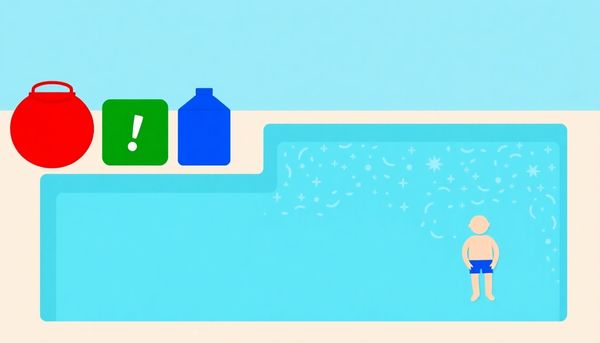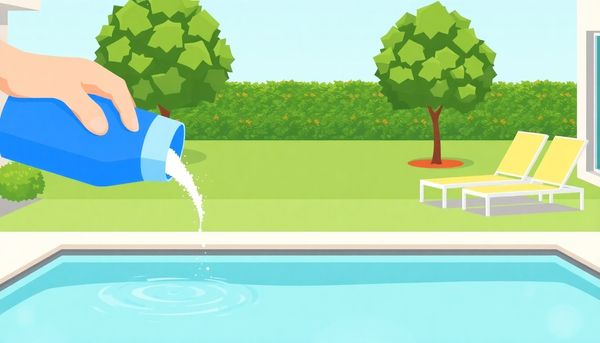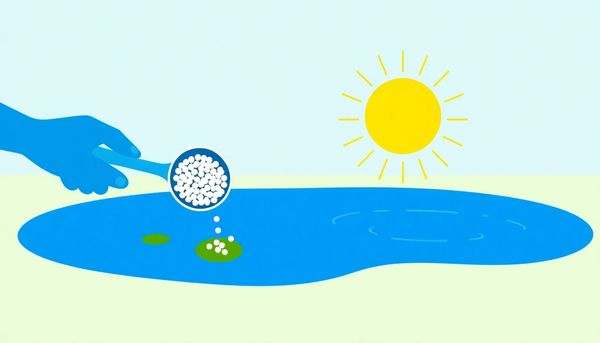Choosing the Best Pool Shock: A Guide to Clear, Safe Swimming
October 15th, 2024
October 15th, 2024
A shimmering oasis on a hot summer day, your swimming pool promises refreshment and relaxation. Yet, to maintain its allure and safety, regular maintenance is crucial. Pool shock, an essential part of this routine, serves to sanitize and reset your pool’s chemistry, ensuring crystal-clear waters. Whether you're a seasoned pool owner or someone who's just dipped their toes into this world, choosing the right type of pool shock can feel like navigating a maze.
Memories of my childhood summers, spent splashing around in my family's pool, often resurface when I think about the nuances of pool care. Back then, I watched my father carefully measure and pour that mysterious white powder, wondering what magic it held. Today, I understand that pool shock is the hero behind the scenes, tackling bacteria, algae, and contaminants that invisibly threaten our watery retreat.
Not all pool shocks are created equal, however. With choices ranging from calcium hypochlorite to sodium dichlor, each type comes with distinct benefits and considerations. For instance, some are more suitable for rapid action, while others offer a gentler, long-term approach. The decision hinges on various factors like pool size, usage frequency, and even climate conditions. By demystifying these options, you can ensure your pool remains a pristine, inviting haven for all those cannonball dives and lazy float sessions.

Selecting the ideal pool shock is akin to setting the perfect stage for a summer soirée. Each pool is unique, revealing its character through water clarity, usage patterns, and the occasional surprise, like an unexpected algae bloom. The aim is to match the shock type not just to the pool's current condition but also its regular rhythm.
Calcium hypochlorite, or cal-hypo, reigns supreme when you need to tackle stubborn algae or murky waters. Its high chlorine content makes it a formidable foe against contaminants, though it does require evening application to avoid UV degradation. However, be mindful—cal-hypo can nudge up the calcium levels, which might not suit pools already flirting with hard water issues.
Conversely, if your pool is a serene retreat with a saltwater system, consider using a softer touch. Dichlor shock, with its stabilized chlorine, won't add to sun-induced woes or cyanuric acid levels, making it a balanced choice for routine care. And for those with a penchant for immediate post-shock swims, potassium monopersulfate, a non-chlorine alternative, allows for quick reentry while maintaining chemical harmony.
Each shock has its niche; the key is aligning its strengths with your pool’s needs. Whether warding off algae or preparing for a splash-filled weekend, understanding these options transforms pool maintenance from a chore into an act of savvy stewardship.
Exploring the world of pool shock can feel akin to navigating a maze, with each turn revealing a new choice. In my own backyard, I once faced the daunting task of rescuing a green, algae-laden pool. That's when cal-hypo shock came to the rescue. Renowned for its strength, it effectively combats algae and clears murky waters. However, it's important to remember that cal-hypo shock can elevate your pool's pH levels and leave calcium residue, demanding vigilance in balancing your water chemistry afterward.
For those who prefer a gentler approach, especially when aiming for a quick swim post-treatment, non-chlorine shock is the go-to. This variety, typically composed of potassium monopersulfate, is ideal for maintaining pools without affecting other chemical levels. It's a favorite among saltwater pool owners, as it doesn’t add chlorine but still helps oxidize contaminants. A friendly reminder from my own trial and error: this type won't tackle algae on its own, so it’s best paired with a chlorination system.
Dichlor shock strikes a balance between potency and convenience. As a stabilized chlorine option, it doesn’t dissipate quickly under the sun, making it perfect for routine maintenance. However, it does increase cyanuric acid levels, so keep an eye on its buildup. It's a reliable choice for both shock treatments and regular chlorination, especially if you’re juggling multiple pool duties. Ultimately, selecting the right shock means understanding your pool's unique needs and conditions, just as a tailor measures every seam and stitch.
Understanding how chlorine affects your pool is crucial for maintaining the perfect swimming environment. Chlorine serves as the primary agent in pool shock treatments, and while it does an exceptional job at keeping algae and bacteria at bay, its byproducts can lead to a few challenges. When chlorine interacts with organic matter like sweat or oils, it forms chloramines. These compounds are notorious for that unmistakable “pool smell” and can irritate eyes and skin, a telltale sign that your pool needs a good shock.
Consider the pool at my friend’s house, which we used frequently one summer. Initially, the seductive scent of chlorine was overwhelming, prompting us to think the water was exceptionally clean. What we overlooked was the strong odor actually indicated an imbalance, with chloramines lurking beneath the surface. After an enlightening chat with a professional, we realized a shock treatment was overdue to restore the water’s health.
It's common to see pool owners grappling with chlorine impacts without understanding the root cause. Regular testing and balancing are essential, especially after heavy usage or storms. If your pool starts resembling a swamp or becomes cloudy, it's not just a visual disturbance but a chemical alarm. Remember, each type of pool shock—from cal-hypo to non-chlorine—has specific applications and impact levels. Choosing the right one ensures not just clear water, but a safe swimming haven where the biggest worry is perfecting your cannonball.
Timing is everything when it comes to pool maintenance, especially with the art of shocking. Choosing the ideal moment to add shock to your pool can significantly influence its effectiveness. Late evening or nighttime is often the best time to introduce your chosen shock treatment. Sunlight, particularly ultraviolet rays, can degrade chlorine components rapidly, diminishing their sanitizing power. By waiting until twilight, you ensure that the chlorine remains in the water longer, doing an effective job against unwanted contaminants.
I remember a summer evening when I decided to shock my pool at sunset. By the next morning, the water was pristine, with no signs of the usual morning cloudiness. This experience taught me that while the chemical products are crucial, timing their application can make all the difference.
Another factor to consider is your pool usage. After heavy pool activity, such as a party or a busy weekend, it's wise to shock your pool immediately after the last swimmer leaves. This helps tackle any organic matter left behind and prevents chloramine buildup. Additionally, it's beneficial to schedule shocks after a heavy rainstorm, which can introduce debris and alter the pool's chemical balance.
Understanding these nuances in timing not only enhances the shock's efficacy but also prolongs the health and clarity of your pool. Taking the time to plan your shock around these natural and usage patterns ensures you get the best possible results.

The battle against algae begins with understanding just how crucial an effective pool shock can be. Algae are not just an aesthetic nuisance; they can clog filters, become slippery hazards, and harbor harmful bacteria. My friend recently discovered this while hosting a summer barbecue. Her sparkling pool turned green overnight, and guests were suddenly more interested in lounging than swimming. It was a clear reminder of the importance of regular shocking.
Choosing the right pool shock is akin to picking the right tool for the job. Calcium hypochlorite, or cal-hypo, is often hailed as a hero in the fight against algae due to its high chlorine content and robust oxidizing properties. It’s especially effective in addressing murky waters and persistent algae growth, but it does require proper handling. Always shock your pool in the evening to protect the chlorine from being degraded by sunlight, which can render the treatment less effective.
For those who maintain a saltwater pool, a different strategy might be necessary. Dichlor shock or non-chlorine shock are more suitable for regular maintenance, ensuring your chlorine levels don’t skyrocket, which could disrupt the delicate balance of saltwater systems. Always remember, the key to preventing algae is not just in the shock treatment itself but in understanding the specific needs and conditions of your pool. By doing so, you ensure that your pool remains inviting, pristine, and a source of enjoyment rather than frustration.
Choosing the right pool shock can feel like navigating a maze of options, each promising to keep your water sparkling and safe for swimmers. The key lies in recognizing your pool's specific needs and understanding what each type of shock brings to the table. Remember the time when a family barbecue turned into an unexpected pool party? That’s when you appreciate having the right shock on hand to ensure your pool remains a welcoming oasis rather than a murky mystery.
Calcium hypochlorite, or cal-hypo shock, stands out for its robust ability to tackle stubborn algae and murky water. It's your best ally when your pool resembles a pond after a heavy rain or an influx of enthusiastic guests. However, it requires careful handling to avoid unwanted side effects like scaling or increased pH levels. For those with saltwater pools, cal-hypo might not be your go-to due to its tendency to disrupt the delicate saltwater balance.
For regular upkeep and less intensive issues, dichlor shock offers a gentler, stabilized option. It’s ideal for maintaining chlorine levels without the risk of sunlight rapidly diminishing its effectiveness. Meanwhile, non-chlorine shock provides a fast-dissolving alternative, perfect for those spontaneous pool dips. It’s especially handy when you want to swim soon after treating your pool. This option, however, won't combat algae as effectively as chlorine-based shocks.
In the end, selecting the appropriate shock is all about balance: understanding the chemistry involved and matching it to your pool’s unique circumstances. It’s this careful selection that transforms pool maintenance from a dreaded chore into a seamless part of enjoying your backyard paradise.
Timing and technique are the unsung heroes of effective pool shocking. A well-timed shock can mean the difference between a sparkling oasis and a murky mess. Begin with understanding your pool's rhythm—when does it see the most activity, and how often is it exposed to contaminants? For most, a late evening or night-time shock is ideal. The chlorine in many pool shocks, like calcium hypochlorite, is unstabilized and can be rapidly degraded by sunlight. Adding it after dusk lets it work its magic undisturbed by UV rays.
On one memorable summer evening, after a bustling weekend of barbeques and cannonballs, I decided to shock my pool right as the sun dipped below the horizon. The following morning, the water was crystal clear, as if nature had hit the reset button. This practice not only helps maintain clarity but also prevents those nastier odors caused by chloramines.
The application itself deserves attention, too. Always read the instructions—some shocks need pre-dissolving, others can be scattered directly. Wearing gloves and protective eyewear isn't just a good idea; it's essential for safety. If using a powder, slowly introduce it to a bucket of water, stirring to dissolve before adding it to the pool. With liquids, walk around the pool’s perimeter, pouring slowly and evenly. This ensures even distribution and maximum effectiveness, keeping your pool ready for the next splash.
After the initial burst of chemicals during pool shock, the work doesn’t end there. The aftermath of shocking demands a keen eye to restore that delicate balance your pool thrives on. Once the chlorine has done its job, it’s essential to ensure that your pool's chemical levels are back in harmony. Chlorine levels might skyrocket, and pH may veer off its ideal path. Your pool's pH should hover between 7.4 and 7.6; a deviation can mean irritated skin or eyes for those looking to take a dip.
One sunny afternoon, I shocked my pool only to find the pH had climbed too high, leading to a mini science experiment in bringing it back to normal. Testing kits are the unsung heroes here. They help detect if the pH is straying beyond comfort, or if the chlorine is still too potent for a safe swim. Baking soda might become your best friend if you need to nudge that pH down or up a notch.
Moreover, keep a watchful eye on alkalinity and calcium hardness—these are the building blocks that maintain water stability. The latter is particularly crucial if you’ve employed cal-hypo shock, as its calcium content can push things over the edge. Regular adjustments and patience do the trick. Remember, each pool is unique; what worked for your neighbor might not be your remedy. A balanced pool isn't just about safety—it’s about ensuring each swim is a pleasant experience.

After a pool shock, the chemistry of your pool water undergoes a significant transformation. While your pool may look pristine and inviting, lurking beneath the surface could be an unbalanced pH level. An optimal pH between 7.4 and 7.6 ensures the water remains safe and comfortable for swimmers. A deviation from this range can quickly turn a refreshing swim into an eye-watering experience or, worse, cause skin irritations.
Having once faced the issue of irritated eyes after a seemingly successful pool shock, I realized the importance of not just focusing on chlorine levels but also on the pH. Cal-hypo shock, known for its powerful chlorination abilities, tends to raise the pH levels, making the pool water more alkaline. If your pH is high, it’s crucial to adjust it back to its ideal range using a pH decreaser. This will help avoid scaling on the pool walls and equipment.
Conversely, if the pH drops too low, it’s time to introduce a pH increaser to prevent the water from becoming too acidic, which is equally unpleasant. Regular testing, especially after shocking, is your best ally. Using test strips or a digital tester gives you a clear snapshot of your pool’s current state, allowing for precise adjustments. Balancing pH might seem like a chore, but it’s the secret to a harmonious and enjoyable swimming environment.
Choosing the right pool shock can feel like picking the right tool from a crowded toolbox: each has a purpose, but using the wrong one can lead to unintended results. I remember a sunny afternoon when my enthusiasm for maintaining a sparkling pool led me to grab the first shock I found. It wasn't long before my pool took on a cloudy tint, a reminder that not all shocks are created equal.
Understanding the nuances between pool shock options is crucial. Calcium hypochlorite, known as cal-hypo, is a powerhouse for tackling stubborn algae and murky waters. It's the go-to choice for pools suffering from serious algae blooms, but it demands careful handling due to its impact on pH levels and potential to cause scaling. On the other hand, dichlor shock, with its stabilized chlorine, is a friendlier alternative for regular maintenance, especially under the sun’s relentless rays. It does raise cyanuric acid levels, though, so it’s best suited for pools not already teetering on high CYA levels.
For those eager to swim soon after, non-chlorine shock offers a gentle solution without altering the pool's chemical balance. Perfect for saltwater systems or hot tubs, it allows you to treat your pool and dive back in within a short span. Selecting the right shock is about understanding your pool's unique needs, ensuring each swim is as enjoyable as the last.
Balancing the pH level of your pool post-shock is a crucial yet often overlooked step in maintaining a healthy swimming environment. After you've added pool shock, whether it's cal-hypo or dichlor, the immediate aftermath is a disruption in the water's chemistry. The pH levels, which ideally hover between 7.4 to 7.6, can be thrown off course, leading to discomfort for swimmers and potential damage to pool equipment.
Imagine inviting friends over for a pool party, only to find them squinting and rubbing their eyes because the water is irritatingly alkaline. Such scenarios are avoidable by simply checking the pH levels after shocking. A high pH level means the water is too basic, causing eye and skin irritation, while a low pH level indicates acidity, which can also be harsh on the skin and corrode your pool fixtures.
To avoid these issues, using a reliable pool testing kit is key. After shocking, test your water the next morning, allowing the chemicals to fully disperse overnight. If the pH level needs adjusting, add pH increaser or decreaser accordingly. For instance, I once underestimated the power of a cal-hypo shock and ended up with a pH level of 8.2. A quick adjustment with a pH decreaser saved the day, bringing it back into the safe zone.
Remember, maintaining balanced pH levels not only ensures swimmer comfort but also extends the longevity of your pool equipment. Regular monitoring and adjustments are your best allies in achieving a sparkling and inviting pool.
Balancing the pH in your pool is like tuning a musical instrument—essential for harmony. When you shock your pool, especially with products like cal-hypo, the delicate equilibrium of your water's chemistry can easily be disturbed. The pH level, a measure of how acidic or basic your pool water is, should ideally rest between 7.4 and 7.6. Too high, and swimmers might complain of itchy eyes and irritated skin. Too low, and that same irritation comes from an acidic bite.
I learned this firsthand after a summer pool party. It was a lively affair, but the next day I noticed everyone who took a dip had red eyes and dry skin. A quick pH test showed that the levels were off the charts. A bit of baking soda and a dose of pH decreaser later, the water was back to its sparkling, balanced self. This experience taught me the importance of testing and adjusting pH levels, especially after using shock treatments.
Every type of pool shock, from calcium hypochlorite to non-chlorine options, impacts pH differently. Therefore, it's vital to have a pH increaser or decreaser on hand. Regular testing should become second nature, like checking the weather before heading out. By keeping your pH in the sweet spot, not only are you ensuring a safer swim, but you're also prolonging the life of your pool surfaces and equipment.

Stepping away from the conventional chlorine shock treatments, let's explore the benefits of choosing non-chlorine shock for your pool. This lesser-known but highly effective alternative is particularly useful if you're looking to maintain a balanced pool chemistry while minimizing downtime. Unlike traditional chlorine-based shocks, non-chlorine shock, primarily composed of potassium monopersulfate, acts as a powerful oxidizer. It targets chloramines and organic contaminants without altering your pool's pH or contributing to rising cyanuric acid levels.
A friend of mine swears by non-chlorine shock for her kids' above-ground pool. Its key advantage is the quick turnaround time—within just 20 minutes of application, the family can dive back in without the irritation often associated with chlorine. This makes it ideal for spontaneous pool parties and camps where waiting for hours isn't an option.
While non-chlorine shock is effective in routine maintenance and keeping the water sparkling clear, it does have its limitations. It's not the go-to choice for tackling stubborn algae blooms or severely cloudy pools. In such situations, a more robust, chlorine-based shock might be necessary to restore water clarity. However, for those with sensitive skin, saltwater systems, or hot tubs, the gentle nature of non-chlorine shock offers a compelling advantage, allowing you to enjoy your aquatic oasis with minimal chemical interference.
Stepping into the realm of pool care, non-chlorine shock treatments often fly under the radar, yet they offer a treasure trove of benefits for pool owners seeking a gentler touch. Picture a serene afternoon with family and friends, and the spontaneity of a quick dip in the pool. Non-chlorine shock makes this possible, as it allows for near-immediate swimming—often within 20 minutes—without the harshness of traditional chlorine shocks.
In terms of chemistry, non-chlorine shock is typically made from potassium monopersulfate, an oxidizer that targets and breaks down organic contaminants without altering chlorine levels. This quality is particularly beneficial for maintaining water balance, a crucial aspect for saltwater pools or spas. For those wary of constantly juggling pH levels, this treatment offers a sigh of relief, as it leaves other chemical parameters intact, maintaining the pool's equilibrium.
A practical tale from my backyard adventures: On a day when a sudden gust of wind tossed leaves and debris into the pool, a quick application of non-chlorine shock cleared up the water swiftly, without the usual waiting game associated with chlorine treatments. It’s a testament to its efficiency and user-friendly nature. Although it won’t battle algae head-on, pair it with a chlorination system, and you've got a reliable partner for routine maintenance. Non-chlorine shock stands as a versatile choice, marrying convenience with effective water care.
In the world of pool maintenance, selecting the ideal shock type can feel like choosing the right tool for an intricate job. Each pool shock variety offers its own advantages, tailored to different needs and situations. Understanding these distinctions can transform your pool from a murky mystery into a crystal-clear oasis.
Calcium hypochlorite, often referred to as cal-hypo, is the heavy hitter in the realm of pool shocks. This option is perfect if your pool battles persistent algae or needs a thorough cleanup. Cal-hypo boasts high chlorine content, making it effective for serious sanitation problems. However, it's important to be mindful of its tendency to raise calcium levels, which can lead to scaling. This heavy-duty shock is best utilized in traditional pools rather than saltwater environments, where it may disrupt the delicate balance.
On the other hand, if your pool maintenance routine includes frequent shocking or you have a saltwater pool, sodium dichloro-s-triazinetrione, or dichlor, may be more suitable. As a stabilized chlorine shock, it’s less prone to degradation by sunlight, although it does increase cyanuric acid levels. This makes it an excellent choice for routine maintenance without the stress of UV loss.
For those seeking a gentle approach, particularly if immediate swimming is on the agenda, non-chlorine shock provides a viable alternative. This option allows swimmers to re-enter the pool within a short time frame, making it ideal for spontaneous poolside gatherings. By using potassium monopersulfate, a non-chlorine shock manages to maintain water clarity without significantly altering chemical balances, though it lacks the punch needed to conquer serious algae issues.
Remember, choosing the right shock type hinges on your pool’s specific needs and your maintenance goals. Whether you’re combating algae or simply maintaining clarity, the right shock can keep your swimming experience refreshing and trouble-free.
In the world of swimming pool maintenance, maintaining the pH balance is often the unsung hero. It’s the silent guardian that ensures your pool remains a safe, comfortable oasis. While shocking your pool with the right chemicals is crucial for eliminating contaminants, it's equally important to keep an eye on the pH levels that these treatments can disrupt. A harmonious pH balance, typically between 7.4 and 7.6, is vital to prevent skin and eye irritation and to ensure that your chlorine works effectively.
Every time I shock my pool, I’m reminded of a chemistry lesson where the slightest imbalance can turn a peaceful environment into chaos. It's like baking a cake; too much flour, and it’s a dry disaster, too little, and it’s a sticky mess. After applying a shock treatment, always test your pool’s pH level. If it's too high, the water feels slippery and can lead to annoying eye irritation. Conversely, water that's too acidic can cause skin discomfort.
To keep things in check, I rely on a simple pH tester kit. It’s a small investment that has saved me countless headaches. If adjustments are needed, pool supplies like pH increasers or reducers become my go-to tools. Just like a gardener tending to plants, a little attention goes a long way in ensuring my pool remains inviting and balanced. So, while shocking your pool is necessary, don’t forget to give the same care to its pH balance.

Every pool owner knows the frustration of stubborn stains marring the pristine beauty of their backyard oasis. Whether it's from organic debris or the notorious algae bloom, dealing with these blemishes can become a daunting task. Enter calcium hypochlorite, or cal-hypo, your pool’s best friend for tackling these tough contenders. Cal-hypo is not just your average pool shock; it's the heavy-duty firefighter for those unruly stains that refuse to budge with regular maintenance.
Imagine coming home after a long week only to find your pool turning a dreaded shade of green. This is where cal-hypo shines. With its potent formula, cal-hypo targets and annihilates algae, ensuring your pool returns to its sparkling glory. Its granule form is simple to use; just follow the instructions for broadcasting directly into the pool or pre-dissolve it depending on the brand. The high chlorine content—between 65% and 75%—guarantees a powerful clean, though with a catch. The calcium in cal-hypo can lead to scaling, so keep an eye on your pool’s chemical balance, especially the pH levels, after treatment.
Using cal-hypo at night maximizes its effectiveness since it's unstabilized and can degrade in sunlight. By dawn, your pool should resemble a clear, inviting blue, ready for the next sunny day. This trusty shock treatment, however, isn’t suitable for every pool type, especially those with saltwater systems, where scaling can become an issue. When used correctly, cal-hypo transforms your pool from a murky mess back into a serene sanctuary.
Maintaining a pool is not just about the splash and laughter; it's about ensuring a clean and safe environment for everyone to enjoy. Regular pool maintenance involves more than skimming leaves off the surface; it's a balance of chemistry and routine. You can't just toss in any pool shock and expect sparkling blue waters. Understanding the intricacies of your pool's needs is key.
When my family got our first pool, I quickly learned the importance of regular maintenance. One summer, our pool turned an unsettling shade of green. It was a wake-up call about the necessity of using the right pool shock correctly. The powerful cal-hypo shock saved the day, but it taught us to respect the chemistry involved. Each pool shock has its own role: cal-hypo for those pesky algae, dichlor for a steady chlorine fix, and non-chlorine options for a quick post-party clean.
Switching up your pool shock depending on the situation is crucial. A friend of mine once neglected to adjust the type of shock after a heavy rainstorm, resulting in a cloudy mess that took days to clear. The lesson here is to be vigilant—check your water's pH and other chemical levels frequently. Keeping an eye on these details ensures you diagnose issues early and keep your pool pristine. Remember, the real magic lies in maintaining the perfect balance, ensuring everyone can dive in safely without a second thought.
Choosing the right pool shock is akin to finding the perfect coffee blend — it all depends on your unique taste or, in this case, your pool's specific needs. First off, let's consider calcium hypochlorite, often referred to as cal-hypo. This might be your go-to if you're dealing with stubborn algae or murky waters that refuse to clear up. It's potent, delivering a hefty dose of chlorine to tackle the toughest of contaminants, but remember to keep it away from saltwater pools to prevent calcium buildup, which can turn into a pesky scaling problem.
On the other hand, if your pool is a saltwater oasis or you’re simply after a gentle maintenance shock, dichlor shock could be your ideal choice. This stabilized chlorine option won’t evaporate under the sun's harsh rays, ensuring your pool maintains a steady level of sanitation. It does, however, add a bit of cyanuric acid, so be cautious if those levels are already creeping up.
For those impromptu pool parties, non-chlorine shock presents a swift solution. This potassium monopersulfate alternative lets you hop back into the water almost immediately, making it a favorite for spontaneous swims. However, it’s not the best choice for battling green water or algae blooms. Each type of shock has its strengths, so matching them to your pool’s specific situation will keep your water sparkling and inviting all season long.

This article provided insights into maintaining your pool. Start your pool care journey today!
Want to become a pool maintenance expert? Our free Pool School course covers everything you need to know about pool care. From basic maintenance to advanced troubleshooting, you'll learn how to:
Join over 10,000 pool owners who have already transformed their pool care routine. Get started with our free Pool School course today!